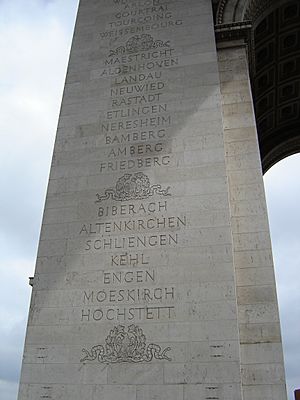Battle of Amberg facts for kids
Quick facts for kids Battle of Amberg |
|||||||
|---|---|---|---|---|---|---|---|
| Part of the Rhine Campaign of the War of the First Coalition | |||||||
 |
|||||||
|
|||||||
| Belligerents | |||||||
| Commanders and leaders | |||||||
| Strength | |||||||
| 34,000 | 40,000 | ||||||
| Casualties and losses | |||||||
| 2,000 | 400 | ||||||
The Battle of Amberg was a major fight that happened on August 24, 1796. It was a key moment in the Rhine Campaign, which was part of a bigger conflict called the War of the First Coalition. In this battle, the Austrian army, led by Archduke Charles, defeated the French army, commanded by Jean-Baptiste Jourdan. This victory was a turning point because the French had been doing very well in the campaign before this battle.
Contents
A Look Back: Why the Battle Happened
War Plans and Armies
In 1796, France planned to invade southern Germany. Two main French armies were involved. General Jean-Baptiste Jourdan led the Army of Sambre-et-Meuse. He planned to advance from the middle part of the Rhine River. Further south, General Jean Moreau led the Army of Rhin-et-Moselle. He planned to cross the Rhine there.
The Austrian forces were led by Archduke Charles. He commanded the Army of the Lower Rhine. His deputy, Wilhelm von Wartensleben, helped him. They faced Jourdan's army along the Lahn River. To the south, another Austrian army, led by Maximilien, Count Baillet de Latour, was ready to defend against Moreau.
Early Summer Fights
In June 1796, the French armies started their advance. Jourdan's army had some early challenges. On June 15, a part of his army met a large Austrian force near Wetzlar. Jourdan had to pull back. Another French general, Jean-Baptiste Kléber, also had to retreat north after a fight near Bonn.
However, Moreau's army in the south had more success. On June 15, Moreau's troops defeated an Austrian force near Speyer. A few days later, on June 24, a part of Moreau's army successfully crossed the Rhine River near Kehl. They defeated the defenders, who were German soldiers. Moreau's army continued to win, pushing the Austrians back.
Because of these defeats in the south, Archduke Charles made a big decision. He left General Wartensleben with about 35,000 soldiers to face Jourdan. Charles then rushed south with 20,000 of his own troops to help Latour fight Moreau.
Mid-Summer Movements
In July, Archduke Charles and Latour tried to stop Moreau. They fought at the Battle of Ettlingen on July 9, but Moreau won again. The Archduke had to retreat far to the east, all the way to Stuttgart.
When Jourdan heard about Moreau's victories, he decided to attack again. His army pushed Wartensleben's forces back towards Frankfurt am Main.
August Advances
Archduke Charles wanted Wartensleben to join him so they could combine their armies and defeat Moreau. But Wartensleben didn't cooperate. On August 11, Moreau defeated Archduke Charles at the Battle of Neresheim. The Austrian southern army retreated further south.
Meanwhile, in the north, Jourdan kept pushing Wartensleben back through Würzburg and Nuremberg. It seemed like Charles's plan to retreat and then combine his forces wasn't working.
The Battle of Amberg
Finding an Opportunity
The situation changed when an Austrian general named Friedrich Joseph, Count of Nauendorf made an important discovery. During a scouting mission, he realized that if Archduke Charles could send about 12,000 men to attack Jourdan's army from behind, Jourdan would be in big trouble.
Archduke Charles quickly acted on this information. He left 30,000 men with Latour to keep an eye on Moreau. Then, he rushed north with 27,000 soldiers. He found Jourdan's army still pushing Wartensleben near Amberg. On August 22, Charles's forces easily pushed aside a French division. This move put Archduke Charles's army right behind the French right side.
The Fight Begins
On August 24, the battle began. Archduke Charles attacked the French army from their right side (the rear). At the same time, Wartensleben attacked the French from the front. The French Army of Sambre-et-Meuse was caught between the two Austrian forces. They were simply outnumbered and couldn't hold their ground.
Jourdan's army was defeated and had to retreat to the northwest. The Austrians had about 40,000 soldiers in the battle and lost only about 400 men. The French had about 34,000 soldiers. They lost 1,200 killed or wounded, and 800 were captured.
What Happened Next
On the very same day as the Battle of Amberg, Moreau's army in the south defeated Latour's forces in Bavaria. However, the big gap between the two French armies was now a serious problem.
As Archduke Charles's victorious Austrians chased Jourdan's defeated army, Moreau realized he couldn't keep going forward. He had to give up his gains and start pulling his army back towards Ulm. The next major battle, the Battle of Würzburg on September 3, would decide the outcome of the entire campaign.

